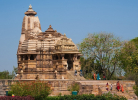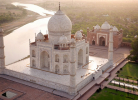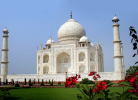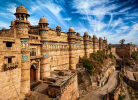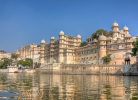Fatehpur Sikri, Agra
-
Famous For History Buffs, Photo Fanatics
-
Duration of Visit Arround 1 Hours
-
Fee 260 per person
-
Visiting Time All days 7:00 AM - 7:00 PM (Except Friday)
Fatehpur Sikri is a small town, little away from Agra. This city was thriving during 16th century under Akbar’s rule. Later, it was abandoned and now, it is an important tourist destination for its monuments, structures and city outline. Akbar had a partial caring towards this city as it is the birthplace of his son and heir to the throne, Jehangir.
Location of Fatehpur Sikri
Fatehpur Sikri is located 39 km away from Agra.
History of Fatehpur Sikri
Prior to mid of 16th century, an old city of Sikri was thriving in this region. A Sheikh in the village predicted that Akbar will have a first son, soon. This was during the time of grief for Akbar as his twin sons from his Rajput wife, Mariam died in infancy. Later, in 1569, Jehangir was born in the same village to Mariam-Uz-Zamani. Akbar commemorated the Sheikh by building a religious compound. Later, a planned walled city was built in the region. The construction of the city was completed during Akbar’s Gujarat campaign. To celebrate the victory of the campaign, Akbar named the city as Fatehpur Sikri, which means City of Victory.
With the light of a recent archaeological evacuation, many statues, antique items and structures of more than 1000 years old were found in the region of Fatehpur Sikri. Before the old city of Sikri, another civilization thrived in this region. Most of these evacuations are related to Jainism.
Several centuries later, Babur and Humayun built the old city as a getaway spot for avoiding the hustle and pressure of Agra. The city was first named as Shukri (Thanks) because Mughal armies used the lake in the city during campaigns. The name later became Sikri.
In 1585, within a few decades from inaugurating the city, the royal family abandoned the city and returned to Agra. Within a few years from then, the entire city was abandoned as the main source of water for the city, the lake dried out, unfortunately. After the complete abandonment, the sons of Akbar stayed in the city during different circumstances like during outburst of a plague, repair work monitoring and so on.
It fell into different hands before reach British’s control in early 19th century. It became and administrative center for the English until independence.
Architecture of Fatehpur Sikri
The entire city runs 3 km in length and one kilometer in width. The city is surrounded by imperial walls of 6 km long on three sides and a lake on the fourth side. The city stands on a ridge, which is 40 m high. The city is predominantly built with red sandstone. You can find Islamic and Gujarati styled architectural features.
The city was built in a hierarchy manner, with better position for royals and noble families. The city can be accessed via any of the large gates namely the Birbal Gate, Lal Gate, Delhi Gate, Gwalior Gate, Tehra Gate, Chandanpal Gate and others.
1. Buland Darwaza
This is the southern gate of the city. This gate’s size decreases gradually, making it harder for advancing armies to enter the fort. This gate has a central portico, which holds three arched entrances. One of the entrances of the gate is called as horseshoe gate. For luck, many horseshoes were hung on the doors, in the past. Right outside the Buland Darwaza, there is a large well, to the left.
2. Jama Masjid
Jama Masjid was the first building to be built in this city. This mosque has a grand entrance to the adjoining courtyard. The main architectural element of this mosque is the chhatris and three mihrabs. The largest mihrab is in the center and it is covered by a small dome. The dome is decorated with geometric patterns in white marble inlay.
3. Tomb of Salim Chishti
This is the tomb of the Sufi Saint, who predicted the birth of Jehangir. This single floor structure has a central chamber of square shape. The grave of saint is under the chamber. The chamber has a wooden canopy decorated with mosaic.
The surrounding walls are decorated with stone pierced screens and jalis with geometric patterns. The tomb is designed in Gujarati style of 15th century. You can find serpentine brackets made with white marbles.
4. Tomb of Islam Khan I (Grandson of Sheikh Salim Chisti)
A little close to the tomb, there is a small red sandstone tomb, built for the Islam Khan I, son of Shaikh Badruddin Chisti and grandson of the Sufi saint Sheikh Salim Chishti, who was a general in the army of Mughal dynasty. This tomb has 36 smaller chattris with domes. Inside this complex, there are numerous unnamed graves, which are assumed to be the family members of the army general.
5. Hall of Public Audience or Diwan-i-Aam
This is the place, where the king lend ears to the public problems, met with common people and staffs. This structure is a pavilion, with a large open space. Very close to the Hall of Public Audience, there is a Turkic Bath and Sultana’s house.
6. Hall of Private Audience or Diwan-I-Khas
This structure is a square plain structure, which the king met with his private audience and ministers. This structure is famous for the massive pillar in the center. It has an octagon shaped shaft fitted with a base of square shape. The pillar is decorated with floral designs, geometric patterns and much more. The circular platform on which Akbar sat is decorated with serpentine brackets. This platform is connected via stone walkways.
7. House of Worship or Ibadat Khana
This house is basically a meeting point, built for developing Akbar’s new religion, syncretistic faith.
8. Anup Talao
This is an ornamental water pool built by King Anup Singh. This pool has four bridges leading to a central platform. This pool is surrounded by numerous royal buildings like Hall of Private Audience, Panch Mahal, House of Dreams and so on.
9. Mariam-uz-Zamani’s Palace
This is the residence of the Rajput queen of King and mother of Jehangir. This building has heavily influence of Gujarati style. The palace surrounds a central courtyard, with high privacy.
10. Naubat Khana
This is the drum house, which hosted the musicians who announced the arrival and departure of the king.
11. Pachisi Court
This is a large room, which is painted as a Ludo board. People were used by coins by the royals for playing the game.
12. Panch Mahal
This structure has five levels, with tapering top. The palace holds one large chhatri. The walls of this palace have pierced stone screen with subdivided interior. The floor holds 176 columns in this room. This is suggested to be a palace for the women of the royal family.
13. House of Birbal
This is the house of Akbar’s favorite minister, Birbal. The house has horizontal sloping chajjas (sunshades) and brackets.
14. Elephant Tower
This is a standalone tower with projections like elephant tusks. It is said to be a memorial tower for the favorite elephant of King Akbar. It is also a milepost.
15. The Mint
The large building to the right of house of drums was the Imperial Mint. The specimens of coins of Fatehpur Sikri of this mint are now in British Museum. This room holds brick domes, which makes this room, the earliest example for such a construction.
16. Stone Cutter’s Mosque
This is a graveyard of son of Sheikh Salim. There are legends that Sheikh transferred the soul of his dead son to the child in the womb of Mariam. A little away the graveyard, a small mosque is located, on the site of the cave, where Salim lived. You can find cornice styled structure with brackets. Wooden imitations and carvings are seen in this mosque.
Why was Fatehpur Sikri Abandoned?
There were numerous stories and reasons given for the abandonment of the city. The most common reason is related to the lake closer to the city, which was considered to be the main source of water. Contrary to the predictions of experts, the lake dried out or the water became unfit for consumption. It is also said that more than 50% of the population of the city were under the age of 6. Thus, it was not easy to maintain such a city as the capital of Mughals. Thus, Akbar returned to Agra and the city slowly disintegrated.
One of the legends state that the Sufi Saint was disturbed by the hassles of the city and demanded that either he should stay or the city should remain. Akbar requested the saint to stay and promised to return to Agra.
Things to do in Fatehpur Sikri
- Sightseeing and architectural photography
- Visit the Hiran Minar, a spiky tower, a little away from Fatehpur Sikri. It is said that King Akbar loves to spot antelopes from this tower.
- Visit the archeological museum, closer to Diwan-i-Aam. This holds pre-Mughal artifacts, and Mughal items.
Entry Fee and Timing of Fatehpur Sikri
- Timing – From sunrise to sunset
- Citizen of India – INR 20 per head
- Citizen of SAARC and BIMSTEC countries – INR 20 per head
- Foreigners – INR 550 per head
Best Time To Visit Fatehpur Sikri
It is best to visit the city by evening and stay there until sunset. The place becomes more photogenic during sunset. The setting sun adds vibrant colors to the red sandstone walls. When it comes to weather, it is better to avoid summers and monsoon. The best time to visit the place is during winter. Winter starts in October and ends in March.
How to Reach Fatehpur Sikri?
The nearest airport to Fatehpur Sikri is located in Agra, 40 km away from it. The nearest railway station is located inside the city. Fatehpur Sikri railway station has regular train services from Agra. If you are looking for common options, choose to fly or reach Agra via road transportation and hire bus or private taxi from Agra to Fatehpur Sikri.












